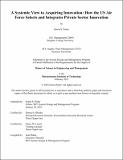A Systemic View to Acquiring Innovation: How the US Air Force Selects and Integrates Private Sector Innovation
Author(s)
Porter, Orson S.
DownloadThesis PDF (3.606Mb)
Advisor
Rhodes, Donna H.
Lyneis, James M.
Terms of use
Metadata
Show full item recordAbstract
The United States Air Force (USAF) is seeing a shift in global powers. In order to stay ahead of the new threat of near-peer advisories, the Chief of Staff of the Air Force established a plan, Accelerate Change or Lose. In this plan, General Charles Q. Brown asks USAF personnel to become innovative problem solvers. One way to bridge this gap is to use the small business innovative research (SBIR) program. Through this program, the USAF funds small businesses with innovative products, technologies, or services and then integrates them into current USAF systems.
The USAF started Pitch Day in 2019 to rapidly fund and contract with innovative companies, with a goal to integrate their products, technologies, or services for end users within the USAF. Shortly afterwards the USAF created AFWERX to standardize process.
Both USAF employees and private sector companies were interviewed in a semi-structured format. USAF employees over each of the processes were interviewed to fully understand the USAF’s approach. Fifty-two companies were also interviewed and the semi-structured format allowed for open-ended questions and provided unfiltered responses.
The information provided by the interviews was then analyzed and overarching themes were identified. The baseline processes are mapped, and the various inputs and outputs required by the USAF and the private sector companies are then added to the baseline process. Social behavior is also added to the process models, which creates a holistic view of the entire system. The social behaviors include both enablers and barriers and include both formal and informal processes. The models help explain how companies move through the entire AFWERX system from Phase 1 to Phase 3, explain how the contracting process works for each solicitation and contract, and explains the possible factors that can lead to the “Valley of Death.”
Within each of these different process flow models, feedback and balancing loops explain how informal requirements actually impact the formal requirements, both positively and negatively. The purpose of this thesis is to propose a new framework that can better enable the USAF and companies to understand the complexities of the government-to-industry innovation system.
Date issued
2023-02Department
System Design and Management Program.Publisher
Massachusetts Institute of Technology